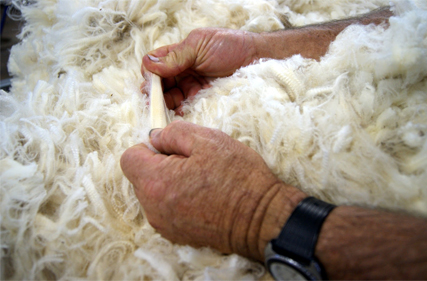 Crossbreds found new vigour with rises of 10-37c measured, and consequently the pass in rate reduced from the pre break levels of 20+% to around 10%. Crossbreds found new vigour with rises of 10-37c measured, and consequently the pass in rate reduced from the pre break levels of 20+% to around 10%.
New business seems to be emerging for the 26-29 μ FNF fleece in China which is thought to be a new emerging fashion item however it is too early to tell if this is an emerging trend of a supply driven price bubble. There is also some renewed interest in the 23-25 comeback combing types destined for low quality uniform orders which are in limited supply at this time of the year. After the mid-year three week recess, the AWEX EMI closed on 1176c down 3c at auction sales in Australia. 49,029 bales were offered with 91% being cleared to the trade. In USD terms the EMI was less flattering with a fall of 24c measured in the opening sales. The early market intelligence was one of little no change on opening, and largely that was achieved with solid support experienced for the majority of the week. Of course, the EMI is derived from several MPG’s and their performance varied in each category. Merino Fleece opened with some vigour across the FNF fleece types 19.5μ and coarser with solid support on the 17.0 and finer. The 17.5-19.0 MPG’s operated within 10c of the previous sales close despite the favourable currency exchange in July. Wednesdays close revealed a weaker sentiment across the majority of fleece types with the exception of the 17+18 MPG which added 10-37c on the previous day’s quotes. Merino Skirtings like the fleece opened slightly dearer to fully firm and unlike the fleece continued to gain positive price momentum as the week progressed. The best skirtings with less than 3% VM were keenly sought after whilst the high VMC types had more difficulty gaining any positive price momentum. |
|
Merino Cardings held their pre break levels in the eastern states with Sydney showing no change whilst Melbourne added 7c for the week. The highlight in this sector came from Western Australia with the Fremantle MC increasing by 24c for the week.
Whilst the optimist could spin a great story out of this week’s wool market results, the reality is that the EMI’s ability to hold within 3c of the closing market in July is indicative of an issue of orders for Chinese bank and railways employees’ uniforms. These orders are expected to be filled in the short term and reports from the trading exporters don’t hold a lot of hope for any new business in the next few months. Chinese economic situation has worsened substantially in imports and export figures linking with the devaluation in their currency. I cannot see any positive news emerging from world economies that will have a positive impact on the current wool market in the short term. As always, I am happy to be proved wrong, and as we know markets are cyclic and inflation will become less prevalent in our major export economies in time. I suspect the recovery will not be in 2023. ~Marty Moses, Moses and Son |
